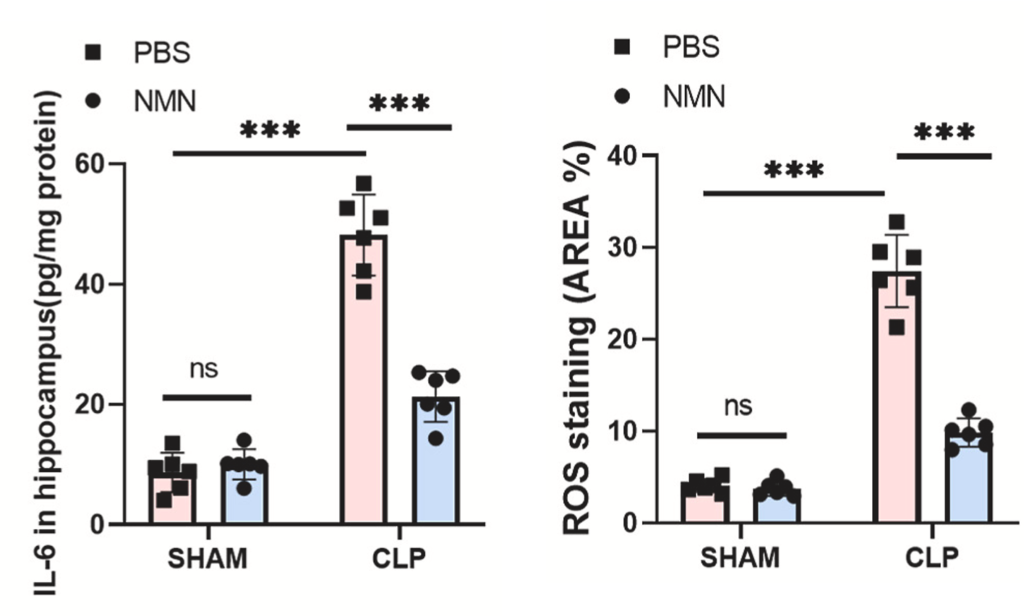Newest Study Indicates NMN Reduces Inflammation and Restores Cognitive Function
NMN improves cognitive abilities and reduces inflammation by activating longevity-associated enzyme SIRT1 in a mouse model for sepsis — a condition that triggers body-wide inflammation.
Highlights:
- Injecting 500 mg/kg of NMN into the bloodstream of septic mice raises NAD+ and SIRT1 levels in the hippocampus — the region of the brain that consolidates memories.
- NMN treatment alleviates the cognitive impairments triggered by sepsis-mediated inflammation.
- Treatment with NMN reduces brain inflammation and oxidative stress — a defect that accompanies inflammation in wreaking havoc on organs and tissues at the cellular level.
While trying its best to fight against infections, our immune system isn’t always kind to us. When overly active or dysregulated, our immune system can attack our organs, causing serious damage. In the case of the brain, perhaps our most precious organ, inflammation overload can lead to cognitive impairments. Albeit, researchers from the Naval Medical University in China have found that NMN can fight against this memory-fogging brain inflammation.
As reported in Redox Biology, Li and colleagues show that NMN activates SIRT1 to counter the immune system’s inflammatory and oxidative stress response. In septic mice, they show that NMN raises NAD+ and SIRT1 levels in the hippocampus, which is associated with improving learning and memory. These findings suggest that NAD+-mediated SIRT1 activation can relieve inflammation-induced cognitive impairments.
NMN Counters Brain Inflammation and Memory Deficits
Sepsis is a life-threatening condition that occurs in response to infection, triggering a cascade of events that promote inflammation throughout the entire body. Hence, to induce sepsis in mice, Li and colleagues surgically punctured the mice’s cecum – part of the gut that contains feces and bacteria. Puncturing the cecum instigates the release of bacteria into the bloodstream, in turn triggering septic shock.
Upon induction, it was found that septic mice had less NAD+ and SIRT1 in their hippocampus. Accordingly, since NMN is known to restore NAD+ levels and activate SIRT1, the researchers injected the septic mice with NMN. This led to an increase in both NAD+ and SIRT1, demonstrating that NMN can cross into the brain and elevate NAD+ to activate SIRT1.

To assess the cognitive abilities of the septic mice, Li and colleagues employed the Morris water maze test, whereby mice were taught to navigate and remember the location of an escape platform. It was found that the septic mice made more errors and took longer to find the platform than normal mice, indicating disturbances in hippocampus-mediated learning and memory. However, NMN improved the ability of septic mice to more easily find the platform, suggesting enhanced cognition.

To explore how NMN could be enhancing cognition in septic mice, Li and colleagues measured hippocampus inflammation and oxidative stress. Oxidative stress is caused by excessive levels of reactive oxygen species (ROS), which cause damage to proteins, lipid membranes, and DNA. Importantly, inflammation evokes oxidative stress.
The results showed that proinflammatory molecules, including IL-6, and ROS levels were dramatically elevated in the hippocampus of septic mice. However, NMN significantly diminished these inflammatory molecules and ROS, demonstrating that NMN can markedly counter inflammation and oxidative stress.

Sirtuin 1 (SIRT1) is an enzyme that consumes NAD+ for fuel. With enough fuel (e.g., from the metabolism of NMN into NAD+), SIRT1 is able to initiate a host of processes associated with longevity. For example, over-activating SIRT1 in the brain (hypothalamus) has been shown to prolong the lifespan of mice.
To clarify whether SIRT1 mediates the observed effects of NMN on septic mice, Li and colleagues repeated their experiments but this time without SIRT1. To do this, they inhibited SIRT1 activity using a drug. They found that blocking SIRT1 negated the cognitive boosting, anti-oxidative, and anti-inflammatory effects of NMN. These findings reveal that NMN counters inflammation-induced cognitive impairments by activating SIRT1.
NMN as an Anti-Inflammatory
Overall, the findings of Li and colleagues suggest that NMM can reduce brain inflammation and relieve any cognitive impairments fostered by an inflamed hippocampus. While sepsis is an extreme inflammatory condition, inflammation can also occur in response to injury and aging. So-called inflammaging refers to the age-related increase in low-grade chronic inflammation that is thought to underlie many chronic diseases, including neurodegenerative disease and cardiovascular disease. Inflammation, including brain inflammation, can even be triggered by certain foods, or environmental toxins in some individuals.
NMN has been shown to reduce inflammation not only in the brain, but also in the skin, gut, lungs, and fat tissue of rodents. By activating SIRT1 via NAD+ production, NMN can improve mitochondrial health, important for reducing ROS generation in our cells. Increasing NAD+ levels in our immune cells can also promote reduced inflammation by restoring aspects of a dysregulated immune system. Therefore, in cases where our immune system is out of control and inflammation ensues inappropriately, NMN could restore energy homeostasis to affected cells and relieve inflamed tissues.
Model: Male C57BL/6J mouse model for sepsis
Dosage: Intraperitoneal (abdominal cavity) injection of 500 mg/kg of NMN

